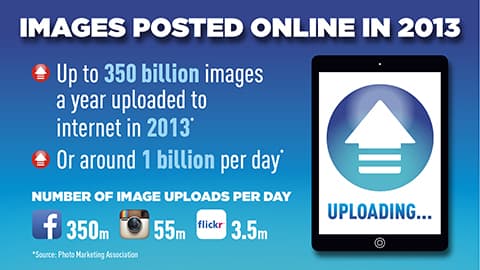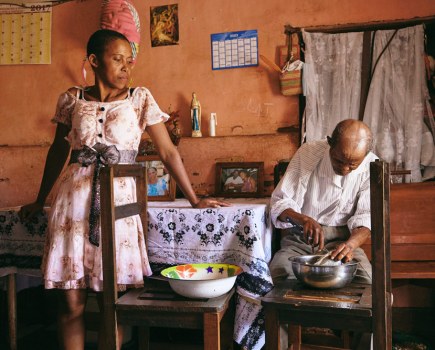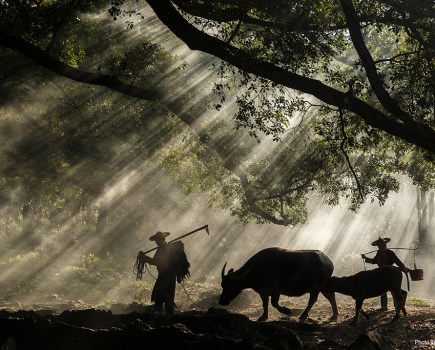Up to 350 billion images were uploaded to the internet last year, according to industry estimates.
That’s more than 50 images for every person alive on the planet. If these were printed as 6x4in photos, and laid end-to-end, the line would stretch almost as far as Mars is from Earth.
Instagram alone says 55 million are posted using its photo-sharing service every day.
VIDEO REPORT (above): Is Getty’s photo rights policy fair? What does it mean? AP interviews industry experts (Graphics: Amateur Photographer magazine)
Images for nothin’, pics for free
Amid such
mind-boggling figures, the world’s largest photo agency, Getty Images, decided
to make 35 million of its pictures (almost a quarter of its entire archive) available for non-commercial purposes on websites and blogs, without
users paying a penny – a move many photographers were quick to condemn.
Internet users can post Getty images on Twitter, for
example, and if they choose later – buy larger versions of the ‘embedded’ photos,
for commercial use, by clicking on a link.
As well as promoting its brand, Getty is rewarded with
information about the websites that use its images and says it may place
adverts next to the photos that appear in the ‘embedded viewer’ window.

(Graphic: Amateur Photographer magazine)
A report by IMGembed, a body that aims to track and monetise online photos, claims that 85% of images are used without permission, according to an article published yesterday in US magazine Popular Photography.
As the colossal scale of online imaging threatens to
send copyright breaches spiralling out of control, was Getty’s move
predictable?
Yes, says Charles Swan, a media rights lawyer whose
practice has seen a ‘massive’ rise in cases over the past few years – largely
down to the proliferation of online images but also because people increasingly
use the Google Image search tool to detect infringements.
He feels Getty’s move is a ‘sign of the times, rather
than good or bad…’
Many copyright thefts not worth chasing
Swan, a director of the Association of Photographers
(AoP), adds: ‘A lot of [copyright] infringements are very minor. They are
people’s blogs… Getty isn’t going to sue them. Not many individual
photographers will.’
While many infringements may be ‘minor’, things can turn
truly nasty at the extreme end of the copyright lottery spectrum.
Last year, Indonesian photographer Hengki Koentjoro fell victim to having his image stolen online by a third party to win
a global photo competition. He is yet to receive an apology from the culprit,
eight months on.

Media rights lawyer Charles Swan
Joe Naylor is CEO of ImageRights International, a US
body that searches for online breaches and pursues compensation for
photographers worldwide. He tells us: ‘One of our photographers had a photo for
the cover of a book used more than 30,000 times online… It’s remarkable, not a
single legal use.’
The dust may have settled in the weeks since Getty’s announcement in March, but this has failed to quell the ire of rights
campaigners.
Getty contributors have since received verbal flack
over the move, from fellow photographers, according to one unconfirmed report.
‘Egregious’ move
Naylor, who describes Getty’s move as ‘pretty egregious’,
adds: ‘Photographers have supplied content under a certain understanding they
are going to be paid…’
Adding insult to injury, it seems, Getty admits it
will not tell photographers about where their images will be used – for now at
least.
‘Even if there’s no revenue, photographers want to
know where [their picture] is and who’s using it, because that could inform
them about what type of content they should focus on in future,’ Naylor says, pointing
out that Getty’s policy was rolled-out ‘unilaterally’ – giving photographers no
chance to opt out.
‘It’s not transparent, which is not a great way to
build a relationship with your contributors.’
In response, Getty tells AP it will ‘explore’ future
data-sharing options.
‘It’s nothing to do with little bloggers’
Also still seething is Jeff Moore, chairman of the
British Press Photographers’ Association (BPPA). He sees no silver lining.
‘If someone owns something [an image] it is up to them
what happens to it….
‘It’s nothing to do with getting fivers and tenners
off little bloggers… whether that
opposition is [agency] Rex Features or 10,000 freelance photographers around
the world… It’s just another way of [Getty] trying to destroy the opposition…
To me, that’s what’s behind it.’

Photographers not paid
Royal
Photographic Society (RPS) director-general Michael Pritchard is more
diplomatic: ‘I think it could be beneficial to photographers because it could
allow them to commercialise work…
‘That
said, the other side is that photographers are not going to be paid for work
they might otherwise have sold.
‘At
the moment I think the jury is very much out and I don’t think we will see how
the situation plays out for another three, six or even nine months.’
Magnum already allows free use
The idea of allowing the public to download
non-watermarked images, for free, is not new however.
Two years ago Magnum
Photos revamped its website to allow users to download images for ‘personal
use’ and blogs.
‘The benefit to Magnum is that we want people to
engage with the work on our website rather than through Google and so on,’ says
a spokesman.
‘We felt watermarks didn’t really protect the images,
as so many of them are out there anyway. We want to draw people to Magnum so
they can engage with what we are up to.’
Magnum declined to comment on Getty’s decision.
The AoP, which serves to protect the rights of
professional photographers, forecasts an unwelcome side-effect.
It warns that photographers pursuing future claims, over
illegal use of images on blogs for example, may find it hard to prove a loss because
Getty is now providing pictures free of charge.
Public perception fears
The AoP fears it also sends the wrong message to the
public and ‘perpetuates the unhealthy idea that images are available for free
use’.
This is echoed by RPS’s Michael Pritchard who adds:
‘As we know and what Amateur Photographer
has been so good about saying is that copyright is important. Photographers
should be protecting their work and this is, perhaps, the one area where the
Getty move falls down…’
The RPS asserts that the term ‘non-commercial’ is also
open to question’, warning that any ensuing confusion may escalate infringements.
‘Getty… has come up with a definition that’s quite
loose in many respects and, from the public’s point of view, most people are not
going to read the terms and
conditions…
‘I suspect the use of the images is going to be so
massive that [Getty] is not going to be able to control, in a big way, how those
images are used’.

Keeping a watching brief: The RPS’s Michael Pritchard
‘Wrong direction’
UK photojournalist Jonathan Mitchell edits the Atlas
Photo Archive. Speaking shortly after Getty’s announcement, he said: ‘It’s
definitely sending people in the wrong direction.’
Moore agrees, as does Nottingham-based photographer and outspoken rights
campaigner Pete Jenkins who says Getty has capitulated to the ‘abandonment of
international copyright law’. He fears it will lead to a rise in copyright
theft.
Jenkins admits he did not see it coming. ‘Many
bloggers and other internet users have been working on the basis that everything
is free on the internet… Will would-be infringers realise that copyright laws have
not actually changed?’
It ‘devalues
photography’
Swan doesn’t expect it to deepen any public perception that images are copyright-free, but concedes that it ‘devalues
photography’ – a view echoed by Mitchell.
In reality, says Swan, the commercial licensing option
may promote the idea that photos are copyright protected.
Naylor explains further: ‘The fact [Getty] are
defining a certain set of images as free implies that there’s images outside
that set that are not free.’
Getty advertising spin-off
Getty reserves the right to place adverts in its Embedded
Viewer, without the photographer seeing any return.
Even if advertising revenue filters through to Getty contributors, Naylor doubts whether it would be ‘meaningful’
and, in any case, says it would worsen the downward pricing pressure in the market for professional images.
‘From a pure business perspective you can’t fault
[Getty]… This is a new way to monetise their content for all non-commercial
uses. It’s just that it is at the expense of the contributor…’
Any good news?
While, the prospect of future commercial licensing
would benefit all, this comes with a ‘big if’, cautions Swan.
Neil Turner, a vice-chairman of the BPPA tells AP: ‘We
work in a market-driven economy but, essentially, this can damage lots of
individual creators and eventually it’s going to trip Getty up as well.’
Others are more positive. Despite having his copyright
breached more than 130 times, AP reader Graham Stephen sees benefits, beyond
those for social media users and bloggers.
‘If Getty’s initiative gains traction then this could also
be good news for creators of original photographic content too, if it can raise
general awareness of image licensing concerns.’
Getty photographer: It’s a ‘positive thing’
The RPS is also upbeat. ‘We welcome the move in terms
of its regularising the illegal use of images and ensuring that photographers
are credited for their work…’ says Pritchard.
Getty contributor Ron Galella, in a statement released
through the agency, adds: ‘As professional photographers, we can never stand
still and resist change that has already happened…
‘When the landscape changes around us, we must be
prepared to recognise that, move on and embrace our next opportunity… Anything
that helps more photographers’ work to be seen by a greater number of people is
a positive thing, especially if that work can be consistently credited and
recognised, be it artistically or editorially.’
Will people want it? Jane Fonda does…
Beyond the fear and loathing, there are doubts over
whether it will prove a hit for Getty.
‘Buyers don’t go to personal blogs to buy content,’
asserts Naylor.
Swan also questions its popularity: ‘If you want to
put a Getty image on your website or a blog which is non-commercial, it will
come out in a format where it will have a big Getty logo on it… How many people
will actually want that?’
Getty is yet to talk numbers, but we know that Jane
Fonda is among the early adopters. The under-fire agency was quick to reveal
that the Hollywood star used Getty’s tool to post a photo of herself on her own
blog on 23 March.

Jane Fonda was among the first to use the Getty tool
Neil Turner doubts it will deliver the ‘shop window’ he
says Getty is hoping for. ‘Photographers work is quite easy to see anyway and
anyone looking for a specific image on a specific topic doesn’t need a Getty
account to browse through the Getty library.
‘So the idea that someone might stumble across
something on a blog somewhere in Texas and then go “wow! that’s the image for
me, I’m going to use it in a multi-thousand pound marketing campaign” is a
pretty big jump to make frankly.’
Photojournalism in jeopardy?
There
are other dangers too. Will smaller agencies pay the price as other agencies
follow suit? Or worse: will it damage
freelance photography and threaten photojournalism itself?
Turner warns: ‘Getty will have set a bar that other
agencies will have to try and follow, so I predict that you are going to get
other agencies following suit, with embedded images, which is not the way to
make this marketplace a viable concern…
‘Will Alamy follow, will Corbis follow? Who knows? But
what we do know is that the photographers concerned are the losers.’

The BPPA’s Neil Turner spoke to AP in a video interview
Small agencies under threat
Michael Pritchard is also vigilant, stressing that
specialist agencies stand a stronger chance of survival: ‘There is a potential
threat to the small stock agencies. Inevitably they are going to have fewer
financial resources to come up with their own scheme and, potentially, I think
we could see one or two of them say “it’s just not worth investment, we can’t
compete with the Getty’s of the world”, and… disappear.’
Alamy, which recently launched a service to ‘monetise
iPhone photos’, based around its new Stockimo app, declined to comment when
approached by AP.
Getty photographer Kevin Mazur is in no doubt that
others will follow Getty’s policy. In a statement released via the agency, Mazur,
a co-founder of press agency WireImage, said: ‘Evolving to embrace technology
that both encourages image sharing and potential new revenue streams, and
respects our rights as artists, is the way forward for the industry.’
A ‘trillion’ pics will be taken in 2014
With Flickr owner Yahoo predicting that nearly a
trillion images will be taken globally in 2014, image sharing can only go one
way, it seems.
The BPPA’s Jeff Moore sees only one outcome though. ‘It’s just another nail in the coffin of freelance
photography and there’s a lot of nails in the coffin already.’
[All photo credits: C Cheesman]
And here is the (old) news…
It’s not just blogs. News websites can use Getty’s
embed tool to garner images to illustrate an article, for free, provided it’s
in the context of a ‘newsworthy’ or ‘public interest story. ‘The problem with
this is that it goes way beyond people’s personal blogs and includes online
news sites in general including, for example, BBC News and Mail Online,’ says
lawyer Charles Swan. And, what about a news website where a story is no longer
topical, many months on – will the image still be allowed? Getty tells us that,
although it reserves the right to ‘remove and restrict’ image use, it currently
has no plan to issue an ‘expiration [date] due to news value’.
Picture data bonanza
Data exchange deals are nothing new. Last October
Getty struck an agreement with social networking site Pinterest where it pays
Getty for metadata, to include when and where a Getty image posted by users was
shot, and the photographer who captured it, for example. This allows Pinterest to
match the extra information against relevant adverts on its site, for instance.
Getty – which uses image recognition technology to identify its images on
Pinterest – says Pinterest users get to ‘have more fun’, while the agency’s photographers
get a credit and a cut of the fee.
CLICK HERE IF YOU WOULD LIKE TO MAKE A COMMENT ON THIS SUBJECT







